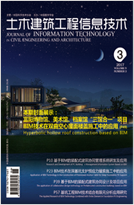2012, 4(1): 1-5.
从节能设计IFC数据生成IDF数据的机制及关键算法
清华大学土木工程系,北京 100084 |
Mechanism and Key Algorithms of Transformation from IFC Data of Design Result to IDF Data for Analysis of Building's Energy Consumption
Department of Civil Engineering, Tsinghua University, Beijing 100084, China |
引用本文:
马智亮, 曾统华, 魏振华, 冯妍. 从节能设计IFC数据生成IDF数据的机制及关键算法[J]. 土木建筑工程信息技术,
2012, 4(1): 1-5.

Citation:
Ma Zhiliang, Zeng Tonghua, Wei Zhenhua, Feng Yan. Mechanism and Key Algorithms of Transformation from IFC Data of Design Result to IDF Data for Analysis of Building's Energy Consumption[J]. Journal of Information Technologyin Civil Engineering and Architecture,
2012, 4(1): 1-5.

摘要:为研制基于BIM技术的建筑节能设计软件,需要实现从IFC数据到能耗模拟软件所需数据的转换。目前国内外已经有一些相关研究,但其具体转换机制和算法并未公开,也没有实现商业化应用。本研究首先建立了建筑节能设计信息需求模型,然后通过分析IFC标准和主流能耗模拟内核EnergyPlus的IDF格式分别建立起了基于IFC标准和IDF格式的建筑节能设计信息模型,之后在该模型的基础上,通过解决一些关键算法建立并实现了由节能设计IFC数据生成ID F数据的转换机制。实际X-程的应用表明所建立的机制能大大提高建模效率。本研究为开发基于B IM技术的我国建筑节能设计软件奠定了基础。
Abstract: Data exchange between BIM (Building Information Modeling)-based application software and energy simulation tools such as EnergyPlus is a critical problem for developing BIM-based building energy-efficient design software. Although there are several related studies, neither the specific mechanisms nor commercial software have been published. In this paper, through analyzing the IFC (Industry Foundation Classes) standard which is the mainstream standard of BIM data, and the IDF (Input Data File) format which is the input format of a well-accepted software for the analysis, i. e. EnergyPlus, both the IFC-based model of design data and the IDF-based information model for the analysis of building s energy consumption were established. Then the mechanism for transformation from the former to the latter was formulated. Finally the mechanism was implemented by establishing several key algorithms in the application software and verified for a project of building design. It is shown that the established mechanism can improve the efficiency of preparing the model for the analysis significantly. This research lays a solid foundation for the development of BIM-based building energy-efficient design software.
| [1] | |
| [2] |
A.Karola, H.Lahtela, R.Hanninen, etc. BSPro COM-Server-Interoperability between software tools using industrial foundation classes [J]. Energy and Buildings. 2002, 34(9):901-907.doi: 10.1016/S0378-7788(02)00066-X |
| [3] |
Tobias Maile, Martin Fischer, Vladimir Bazjanac. Building energy performance simulation tools: a life-cycle and interoperable perspective[R], Center for Integrated Facility En-gineering working paper, Stanford University. 2007. |
| [4] |
V.Bazjanac.Implementation of semi-automated energy performance simxilation: building geometry: Proceedings of Managing IT in Construction / Managing Construction for Tomorrow. United Kingdom[C]. CRC Press, United Kingdom, 2009. |
| [5] |
V. Bazjanac. IFC HVAC INTERFACE to EnergyPlus-a case of expanded interoperability for energy simulation: Proceedings of Building Simulation 2004, USA [ C ]. USA, 2004. |
| [6] |
Chris Wilkins, Arto Kiviniemi. Engineering centric BIM [J]. ASHRAE Journal. 2008, 12; 44-48. |
| [7] |
AutodesJc. Using Green Building Studio with Revit Architecture and Revit MEP[0L]. [2011-10-18] http://wiki-help.autodesk.com/Green_Buildin_Studio/enu/2012/Help/0002-Getting_2/0003-Using_Gr3. |
| [8] |
Designbuilder Software. Designbuilder[OL]. [2011-10-18] http://www.designbuilder.co.uk/content/view/7/13. |
| [9] |
Yun Kyu Yi, Jaime Lee, etc. Data-centric simulation interoperability using the DeST simulation platform: Proceedings of Building Simulation 2007, USA [ C ]. USA, 2007. |
| [10] |
魏振华, 马智亮.基于免费组件的IFC数据三维图形交互模块研究[J].土木建筑工程信息技术, 2011, 3 (4):1-4. |
| [11] |
王勇, 张建平, 胡振中.建筑施工IFC数据描述标准的研究[J].土木建筑工程信息技术, 2011, 3 (4) :9-15. |
计量
- PDF下载量(11)
- 文章访问量(1591)
- HTML全文浏览量(916)















